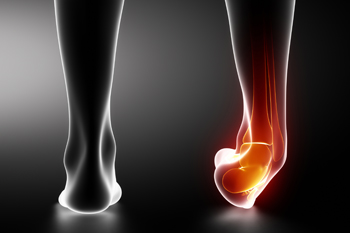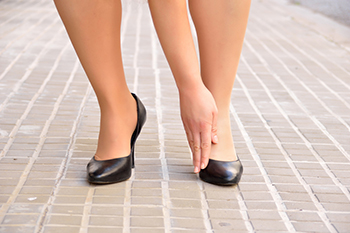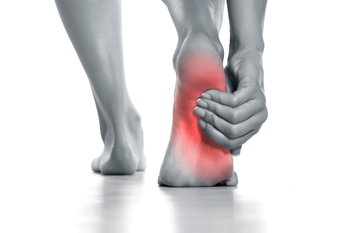Connect With Us
Blog
Items filtered by date: July 2025
Reminder: When Was the Last Time...?
Healing a Broken Ankle Starts With Walking Sooner

A broken ankle often brings thoughts of rest and staying off your feet completely. However, getting back to walking as soon as your podiatrist says it is safe can actually help your ankle heal better. Walking helps improve blood flow to the injury, reduces swelling, and encourages the bones to heal in the correct position. Avoiding movement for too long can cause muscles to weaken and joints to stiffen, which can make recovery take longer. Your podiatrist may recommend starting with a walking boot to protect the ankle as you slowly begin to bear weight. Controlled movement helps prevent complications like joint stiffness and blood clots. Gentle walking also helps restore strength and balance, especially when combined with targeted exercises designed to support your recovery. If you have broken your ankle, it is suggested you schedule a visit with a podiatrist to create a safe and effective healing plan.
Broken ankles need immediate treatment. If you are seeking treatment, contact Dr. Howard Horowitz from Bowie Foot & Ankle . Our doctor can provide the care you need to keep you pain-free and on your feet.
Broken Ankles
A broken ankle is experienced when a person fractures their tibia or fibula in the lower leg and ankle area. Both of these bones are attached at the bottom of the leg and combine to form what we know to be our ankle.
When a physician is referring to a break of the ankle, he or she is usually referring to a break in the area where the tibia and fibula are joined to create our ankle joint. Ankles are more prone to fractures because the ankle is an area that suffers a lot of pressure and stress. There are some obvious signs when a person experiences a fractured ankle, and the following symptoms may be present.
Symptoms of a Fractured Ankle
- Excessive pain when the area is touched or when any pressure is placed on the ankle
- Swelling around the area
- Bruising of the area
- Area appears to be deformed
If you suspect an ankle fracture, it is recommended to seek treatment as soon as possible. The sooner you have your podiatrist diagnose the fracture, the quicker you’ll be on the way towards recovery.
If you have any questions, please feel free to contact our office located in Bowie, MD . We offer the newest diagnostic and treatment technologies for all your foot care needs.
Beauty Meets Foot Health

Many women love high heels for the way they enhance posture, style, and confidence. However, frequent wear can take a serious toll on foot health. High heels shift weight forward, placing excessive pressure on the toes and the balls of the feet. This can lead to bunions, hammertoes, nerve pain, and even long-term joint damage. Wearing heels regularly may also affect balance and cause strain in the ankles and lower back. A podiatrist can identify early signs of damage, provide relief, and suggest supportive alternatives or custom inserts. If you enjoy wearing high heels but notice foot pain or discomfort, it is suggested that you consult a podiatrist who can treat various foot conditions, and guide you on types of heels that might be easier on your feet.
High heels have a history of causing foot and ankle problems. If you have any concerns about your feet or ankles, contact Dr. Howard Horowitz from Bowie Foot & Ankle . Our doctor can provide the care you need to keep you pain-free and on your feet.
Effects of High Heels on the Feet
High heels are popular shoes among women because of their many styles and societal appeal. Despite this, high heels can still cause many health problems if worn too frequently.
Which Parts of My Body Will Be Affected by High Heels?
- Ankle Joints
- Achilles Tendon – May shorten and stiffen with prolonged wear
- Balls of the Feet
- Knees – Heels cause the knees to bend constantly, creating stress on them
- Back – They decrease the spine’s ability to absorb shock, which may lead to back pain. The vertebrae of the lower back may compress.
What Kinds of Foot Problems Can Develop from Wearing High Heels?
- Corns
- Calluses
- Hammertoe
- Bunions
- Morton’s Neuroma
- Plantar Fasciitis
How Can I Still Wear High Heels and Maintain Foot Health?
If you want to wear high heeled shoes, make sure that you are not wearing them every day, as this will help prevent long term physical problems. Try wearing thicker heels as opposed to stilettos to distribute weight more evenly across the feet. Always make sure you are wearing the proper shoes for the right occasion, such as sneakers for exercising. If you walk to work, try carrying your heels with you and changing into them once you arrive at work. Adding inserts to your heels can help cushion your feet and absorb shock. Full foot inserts or metatarsal pads are available.
If you have any questions, please feel free to contact our office located in Bowie, MD . We offer the newest diagnostic and treatment technologies for all your foot care needs.
When Should Toddlers Start Wearing Shoes?

Toddlers should begin wearing shoes when they start walking outdoors to protect their feet from rough surfaces and potential injury. Indoors, bare feet or non-slip socks help develop balance and strength. The right shoes should be flexible, lightweight, and provide enough room for natural foot movement. A wide toe box, breathable material, and a firm but gentle sole are ideal. Wearing ill-fitting shoes can lead to discomfort or long-term foot issues. A podiatrist can assess your child’s foot development and offer guidance on proper footwear and growth milestones. If you are unsure about the right time or type of shoes for your toddler, it is suggested that you visit a podiatrist for personalized care and expert advice.
Making sure that your children maintain good foot health is very important as they grow. If you have any questions, contact Dr. Howard Horowitz of Bowie Foot & Ankle . Our doctor can provide the care you need to keep you pain-free and on your feet.
Keeping Children's Feet Healthy
Having healthy feet during childhood can help prevent medical problems later in life, namely in the back and legs. As children grow, their feet require different types of care. Here are some things to consider...
Although babies do not walk yet, it is still very important to take care of their feet.
Avoid putting tight shoes or socks on his or her feet.
Allow the baby to stretch and kick his or her feet to feel comfortable.
As a toddler, kids are now on the move and begin to develop differently. At this age, toddlers are getting a feel for walking, so don’t be alarmed if your toddler is unsteady or ‘walks funny’.
As your child gets older, it is important to teach them how to take care of their feet.
Show them proper hygiene to prevent infections such as fungus.
Be watchful for any pain or injury.
Have all injuries checked by a doctor as soon as possible.
Comfortable, protective shoes should always be worn, especially at play.
If you have any questions, please feel free to contact our office located in Bowie, MD . We offer the newest diagnostic and treatment technologies for all your foot care needs.
Types of Foot Surgery for Common Conditions

When foot pain does not improve with conservative care, surgery may be considered to restore comfort and function. For those with arthritis, procedures may involve removing damaged tissue, fusing joints to limit painful motion, or replacing the joint entirely. Hammertoe correction often includes straightening the toe by releasing tight tendons or removing part of the bone to improve alignment. In more severe cases, small implants or joint fusion may be used. Heel-related surgeries can address chronic conditions such as heel spurs or plantar fasciitis by removing bony growths or releasing tight tissue that causes strain. Each procedure is selected based on the individual’s condition, level of discomfort, and response to non-surgical treatments. Recovery times and outcomes vary, but many patients experience significant improvement in movement and pain relief. If foot pain from conditions such as arthritis, deformity, or chronic heel issues is interfering with your daily life, it is suggested that you consult a podiatrist for evaluation and appropriate care.
Foot surgery is sometimes necessary to treat a foot ailment. To learn more, contact Dr. Howard Horowitz of Bowie Foot & Ankle . Our doctor will assist you with all of your foot and ankle needs.
When Is Surgery Necessary?
Foot and ankle surgery is generally reserved for cases in which less invasive, conservative procedures have failed to alleviate the problem. Some of the cases in which surgery may be necessary include:
- Removing foot deformities like bunions and bone spurs
- Severe arthritis that has caused bone issues
- Cosmetic reconstruction
What Types of Surgery Are There?
The type of surgery you receive will depend on the nature of the problem you have. Some of the possible surgeries include:
- Bunionectomy for painful bunions
- Surgical fusion for realignment of bones
- Neuropathy decompression surgery to treat nerve damage
Benefits of Surgery
Although surgery is usually a last resort, it can provide more complete pain relief compared to non-surgical methods and may allow you to finally resume full activity.
Surgical techniques have also become increasingly sophisticated. Techniques like endoscopic surgery allow for smaller incisions and faster recovery times.
If you have any questions, please feel free to contact our office located in Bowie, MD . We offer the newest diagnostic and treatment technologies for all your foot care needs.
Understanding Pain on the Bottom of the Foot

Discomfort on the underside of the foot can come from several sources and may interfere with walking or standing. A common reason is strain on the thick tissue that supports the arch, which can lead to soreness near the heel or through the middle of the foot. This discomfort may be more noticeable when getting out of bed or after long periods of time on your feet. Other possible causes include nerve irritation, added pressure on the front of the foot, or inflammation near the heel. Wearing poor footwear, long hours of standing, or overuse during activity may increase the chances of pain. Without proper care, these symptoms may linger or get worse, over time. If you are noticing ongoing soreness on the bottom of your foot, it is suggested that you schedule an appointment with a podiatrist for a diagnosis and appropriate treatment.
Foot Pain
Foot pain can be extremely painful and debilitating. If you have a foot pain, consult with Dr. Howard Horowitz from Bowie Foot & Ankle . Our doctor will assess your condition and provide you with quality foot and ankle treatment.
Causes
Foot pain is a very broad condition that could be caused by one or more ailments. The most common include:
- Bunions
- Hammertoes
- Plantar Fasciitis
- Bone Spurs
- Corns
- Tarsal Tunnel Syndrome
- Ingrown Toenails
- Arthritis (such as Gout, Rheumatoid, and Osteoarthritis)
- Flat Feet
- Injury (from stress fractures, broken toe, foot, ankle, Achilles tendon ruptures, and sprains)
- And more
Diagnosis
To figure out the cause of foot pain, podiatrists utilize several different methods. This can range from simple visual inspections and sensation tests to X-rays and MRI scans. Prior medical history, family medical history, and any recent physical traumatic events will all be taken into consideration for a proper diagnosis.
Treatment
Treatment depends upon the cause of the foot pain. Whether it is resting, staying off the foot, or having surgery; podiatrists have a number of treatment options available for foot pain.
If you have any questions, please feel free to contact our office located in Bowie, MD . We offer the newest diagnostic and treatment technologies for all your foot care needs.

